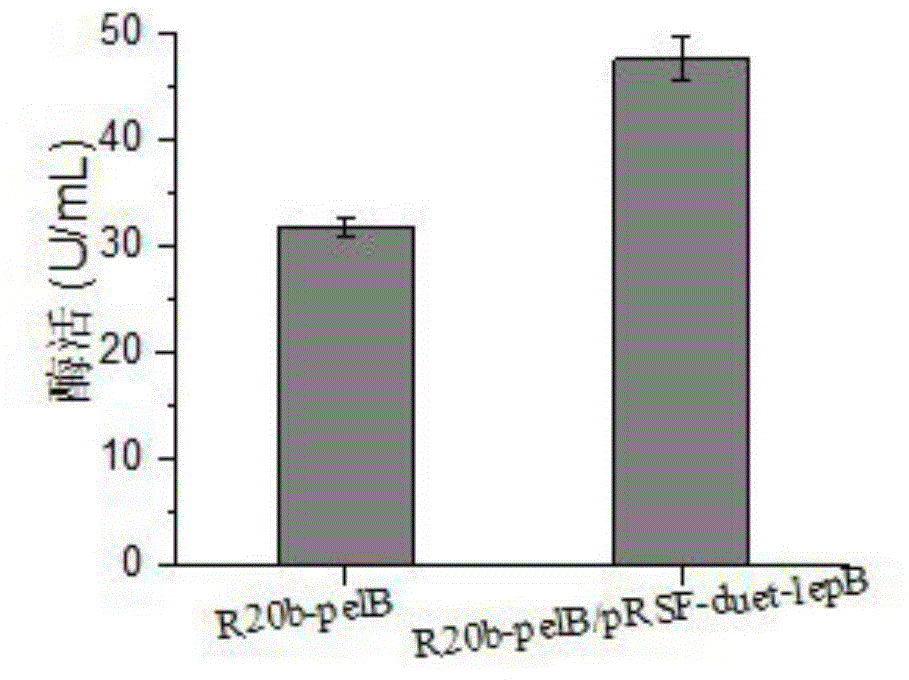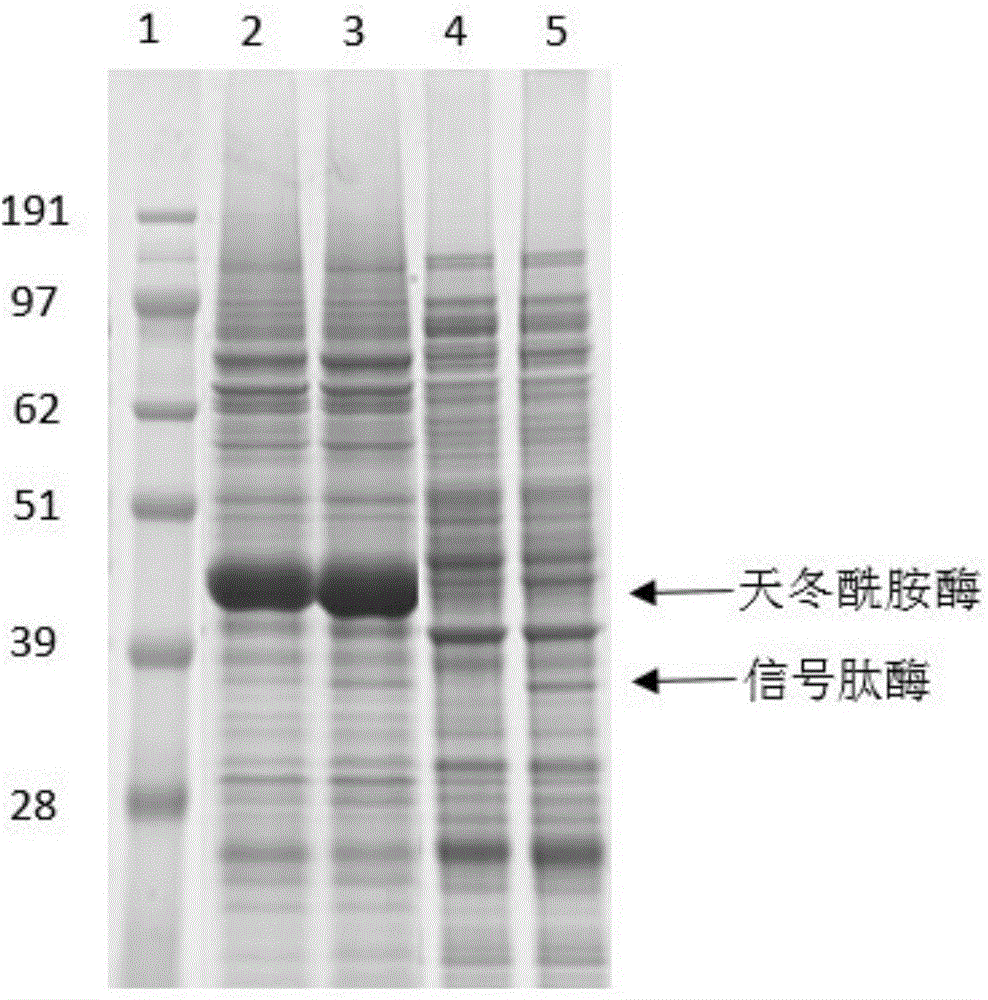Method for improving secretory expression of L-asparaginase
An asparaginase, secretory expression technology, applied in the field of genetic engineering, can solve the problems of complex extraction process, low L-asparaginase content, low L-asparaginase yield, etc., so as to reduce production cost and yield. The effect of improving enzyme capacity and improving production efficiency
- Summary
- Abstract
- Description
- Claims
- Application Information
AI Technical Summary
Problems solved by technology
Method used
Image
Examples
Embodiment 1
[0033] Embodiment 1 asparaginase gene fusion signal peptide
[0034] Nucleotide sequence of signal peptide pelB: ATGAAATACCTGCTGCCGACCGCTGCTGCGGTCTGCTGCTCCTCGCTGCCCAGCCGGCGATGGCC
[0035] Nucleotide sequence of signal peptide ompA: ATGAAAAAGACAGCTATCGCGATTGCAGTGGCACTGGCTGGTTTCGCTACCGTAGCGCAGGCCGCTCCG
[0036] Nucleotide sequence of signal peptide torT: ATGCGCGTACTGCTATTTTTACTTCTTTCCCTTTTCATGTTGCCGGCATTTTCGGCTGAT
[0037] The nucleotide sequence of the signal peptide TorA: ATGAACAATAACGATCTCTTTCAGGCATCACGTCGGCGTTTTCTGGCACAACTCGGCGGCTTAACCGTCGCCGGGATGCTGGGGCCGTCATTGTTAACGCCGCGACGTGCGACTGCGGCGCAAGCG
[0038] Nucleotide sequence of signal peptide sufI: ATGTCACTCAGTCGGCGTCAGTTCATTCAGGCATCGGGGATTGCACTTTGTGCAGGCGCTGTTCCCCTGAAGGCCAGCGCAGCCGGG
[0039] Nucleotide sequence of signal peptide DsbA: ATGAAAAAGATTTGGCTGGCGCTGGCTGGTTTAGTTTTTAGCGTTTAGCGCATCGGCGGCGCAG
[0040] Nucleotide sequence of signal peptide Dmsa: ATGGAACGCAGAAGTTTTCTAAAAATGAGTGCAGCCATGGGCTGCGCAGCAACGGTCACTGGCTGT
[0...
Embodiment 2
[0049] Embodiment 2 fusion fragment is connected with carrier pET-20b (+)
[0050] The recovered product was double digested with restriction endonucleases NdeI and XhoI, and the target fragment was further recovered using a column recovery kit. The fusion fragment was ligated with the carrier pET-20b(+), and the ligation system: 4 μL of the fusion fragment, 1 μL of the vector pET20b, 5 μL of solution I, ligated overnight at 16°C. Transform the ligated recombinant plasmid pET20b-SP-ansZ into competent E.coil JM109, and use ampicillin LB plates to pick positive colonies. The plasmid was extracted after overnight culture on a shaker at 37°C and named pET20b-SP-ansZ. After the enzyme digestion was verified to be correct, the transformant was sequenced by Shanghai Sangon. Transform the plasmid with correct sequencing into Escherichia coli Rosetta (DE3) to obtain asparaginase-producing genetically engineered bacteria.
Embodiment 3
[0051] Example 3 Verification of high-yield asparaginase production strains
[0052] The plasmid with correct sequencing was transformed into E.coli Rosetta (DE3), the selected transformants were inoculated into LB liquid medium, cultured at 37°C for 12 hours, and then transferred into TB medium with an inoculum size of 3%. Bacteria grow to OD 600 When it was 1.5, IPTG was added to induce, and the culture temperature was lowered to 30°C, and cultured for 24h. Collect the fermentation supernatant and detect the enzyme activity of the fermentation supernatant, the results are as follows: figure 1 shown. The experimental results showed that compared with the starting strain, the enzyme activities were significantly improved, and the enzyme activities in the recombinant bacteria fused with signal peptides ansZ, TorA, Sufl, Tort, DsbA, Dmsa, ompA, and pelB were 1.43, 1.74, 1.40, 5.40, 0.98, 3.45, 6.89, 9.72, 31.71U / ml, the asparaginase activity of the recombinant strain R20b-pel...
PUM
 Login to View More
Login to View More Abstract
Description
Claims
Application Information
 Login to View More
Login to View More - R&D
- Intellectual Property
- Life Sciences
- Materials
- Tech Scout
- Unparalleled Data Quality
- Higher Quality Content
- 60% Fewer Hallucinations
Browse by: Latest US Patents, China's latest patents, Technical Efficacy Thesaurus, Application Domain, Technology Topic, Popular Technical Reports.
© 2025 PatSnap. All rights reserved.Legal|Privacy policy|Modern Slavery Act Transparency Statement|Sitemap|About US| Contact US: help@patsnap.com



